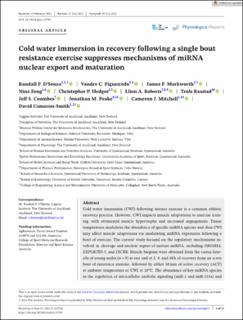Cold water immersion in recovery following a single bout resistance exercise suppresses mechanisms of miRNA nuclear export and maturation
| dc.contributor.author | D'Souza, Randall F. | |
| dc.contributor.author | Figueiredo, Vandre C. | |
| dc.contributor.author | Markworth, James F. | |
| dc.contributor.author | Zeng, Nina | |
| dc.contributor.author | Hedges, Christopher P. | |
| dc.contributor.author | Roberts, Llion A. | |
| dc.contributor.author | Raastad, Truls | |
| dc.contributor.author | Coombes, Jeff S. | |
| dc.contributor.author | Peake, Jonathan M. | |
| dc.contributor.author | Mitchell, Cameron J. | |
| dc.contributor.author | Cameron-Smith, David | |
| dc.date.accessioned | 2024-03-15T14:40:22Z | |
| dc.date.available | 2024-03-15T14:40:22Z | |
| dc.date.created | 2023-09-13T09:49:14Z | |
| dc.date.issued | 2023 | |
| dc.identifier.citation | Physiological Reports. 2023, 11(15), Artikkel e15784. | en_US |
| dc.identifier.issn | 2051-817X | |
| dc.identifier.uri | https://hdl.handle.net/11250/3122720 | |
| dc.description | This is an open access article under the terms of the Creative Commons Attribution License, which permits use, distribution and reproduction in any medium, provided the original work is properly cited. | en_US |
| dc.description.abstract | Cold water immersion (CWI) following intense exercise is a common athletic recovery practice. However, CWI impacts muscle adaptations to exercise training, with attenuated muscle hypertrophy and increased angiogenesis. Tissue temperature modulates the abundance of specific miRNA species and thus CWI may affect muscle adaptations via modulating miRNA expression following a bout of exercise. The current study focused on the regulatory mechanisms involved in cleavage and nuclear export of mature miRNA, including DROSHA, EXPORTIN-5, and DICER. Muscle biopsies were obtained from the vastus lateralis of young males (n = 9) at rest and at 2, 4, and 48 h of recovery from an acute bout of resistance exercise, followed by either 10 min of active recovery (ACT) at ambient temperature or CWI at 10°C. The abundance of key miRNA species in the regulation of intracellular anabolic signaling (miR-1 and miR-133a) and angiogenesis (miR-15a and miR-126) were measured, along with several gene targets implicated in satellite cell dynamics (NCAM and PAX7) and angiogenesis (VEGF and SPRED-1). When compared to ACT, CWI suppressed mRNA expression of DROSHA (24 h p = 0.025 and 48 h p = 0.017), EXPORTIN-5 (24 h p = 0.008), and DICER (24 h p = 0.0034). Of the analyzed miRNA species, miR-133a (24 h p < 0.001 and 48 h p = 0.007) and miR-126 (24 h p < 0.001 and 48 h p < 0.001) remained elevated at 24 h post-exercise in the CWI trial only. Potential gene targets of these miRNA, however, did not differ between trials. CWI may therefore impact miRNA abundance in skeletal muscle, although the precise physiological relevance needs further investigation. | en_US |
| dc.language.iso | eng | en_US |
| dc.subject | cold water immersion | en_US |
| dc.subject | microRNA export | en_US |
| dc.subject | microRNA maturation | en_US |
| dc.subject | resistance exercise | en_US |
| dc.title | Cold water immersion in recovery following a single bout resistance exercise suppresses mechanisms of miRNA nuclear export and maturation | en_US |
| dc.type | Peer reviewed | en_US |
| dc.type | Journal article | en_US |
| dc.description.version | publishedVersion | en_US |
| dc.rights.holder | © 2023 The Authors | en_US |
| dc.source.pagenumber | 11 | en_US |
| dc.source.volume | 11 | en_US |
| dc.source.journal | Physiological Reports | en_US |
| dc.source.issue | 15 | en_US |
| dc.identifier.doi | 10.14814/phy2.15784 | |
| dc.identifier.cristin | 2174567 | |
| dc.description.localcode | Institutt for fysisk prestasjonsevne / Department of Physical Performance | en_US |
| dc.source.articlenumber | e15784 | en_US |
| cristin.ispublished | true | |
| cristin.fulltext | original | |
| cristin.qualitycode | 1 |
Tilhørende fil(er)
Denne innførselen finnes i følgende samling(er)
-
Artikler / Articles [2097]
-
Publikasjoner fra Cristin [1085]
